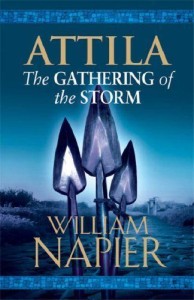 Attila: The Gathering of the Storm by Wiliam Napier
Attila: The Gathering of the Storm by Wiliam Napier
2 out of 5
So this is marginally better than the first in the series. It deals with Attila’s return from exile and his gathering of the various Hun tribes to march against Rome.
That’s about it. Not much else happens in the plot. In my last review I said that his major problem was trying to squeeze in as many facts about Rome as possible to the detriment of pacing or characterisation. This problem all but disappeared when Attila returned to the Huns, the only information we have about the Huns is from a Roman perspective, we have no sources from their point of view. So for the last 50 pages or so the story really picked up because he didn’t have hundreds of facts to show off. This installment is told almost entirely from the point of view of the Huns and if far better for it. My favourite character, the Hun shaman and token madman Little Bird, is much more prominent here. The story opens up with a lot more action, Attila usurping King Ruga, and there is some mystery about how exactly he intends to get his revenge on Rome. He also displays a sense of humour, largely absent from the previous book, in the character of Little Bird, in occassional jokes amongst the men and in ironically scorning novels as ‘arrant nonsense that openly delights the unlettered multitude ‘ (78). (Novels were considered pretty trashy in the ancient world)
And then he ruins it all with a 60 page digression summing up what’s been happening in Rome in the past thirty years. 60 pages! It just goes on and on. I wouldn’t have minded so much if he had actually told it as a story but he skims over nearly everything, providing a summary so that we never actually get to know more than a cardboard version of any character.
This tendency to summarise rather than involve the reader in the moment, I feel, is Napier’s biggest problem. His narrator for the series is Priscus of Panium, the only historical account surviving from this period. As such he attempts to imitate the ancient style of historical chronicles, which frankly can get pretty boring. We have very little of the internal deliberations of characters, rather their actions are summarised and padded out with endless description.
Once he returns to the Huns this description is everywhere and I found myself skipping over paragraphs and sometimed even pages only to have missed nothing but a three page monologue on some opposing barbarians tattoos and topknot. He is very good at describing battles and the acts of cruelty common in ancient histories (But the battles are much more engaging). Overall there is far too much description that doesn’t add to anything and there is still not enough plot. The book could have done with more editing, especially to get rid of errors in continuity such as Attila berating a man for shooting a horse when they attack a column, then his very next order is to shoot the horses. Similarly Priscus applauds the woman Athenais for boldly defending herself in court full of men and refusing the emperor’s offer, then condemns women who are audacious enough to sit at the table with their husband and his friends. Also his characters occassionally quote Shakespeare which gets kind of annoying condidering the story is set 1100 years before Shakespeare. I’d say Napier didn’t realise he was doing this, some half remmebered quote from school just seemed to fit the situation he was writing about but it is a bit jarring when barbarians and Romans say things like ‘it is an honour that I dream not of’ (Romeo and Juliet) and describe jealousy as a ‘green-eyed monster’ (Othello).
His characters clairvoyance from the previous book is replaced with a remarkable passivity in this one. They follow Attila unquestioningly. He returns after a thirty year exile for treason, murders their King in his own tent and declares himself ruler and everyone just nods along. He defeats the Kutriger Huns in battle, a people Napier repeatedly describes as filled with bloodlust and extremely cruel, but rather than seek vengeance they join him. He slaughters hundreds of their warriors in battle and threatens their women and children and then the Kutriger force of thousands bow down to Attila’s 80 remaining men. It is for these reasons that his slight improvements (such as hugely cutting back on infodumps, his sense of humour and his vivid battle scenes) do not make up for the lapses in this story for me.
Overall I didn’t enjoy reading this which made it feel far too long, for anyone wanting to learn about Attila pick up a textbook. I don’t think I’ll read the next one for a long time.